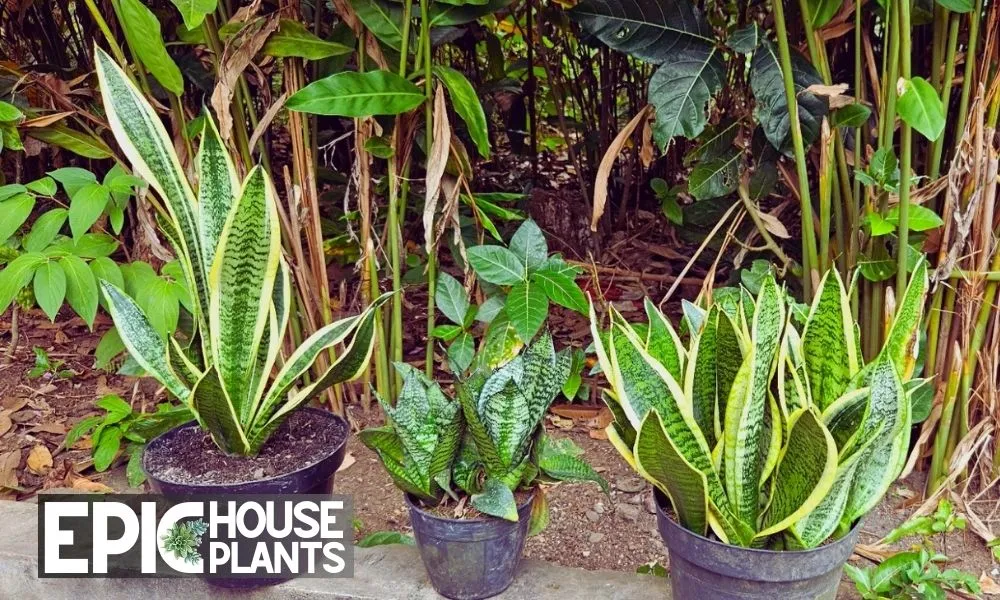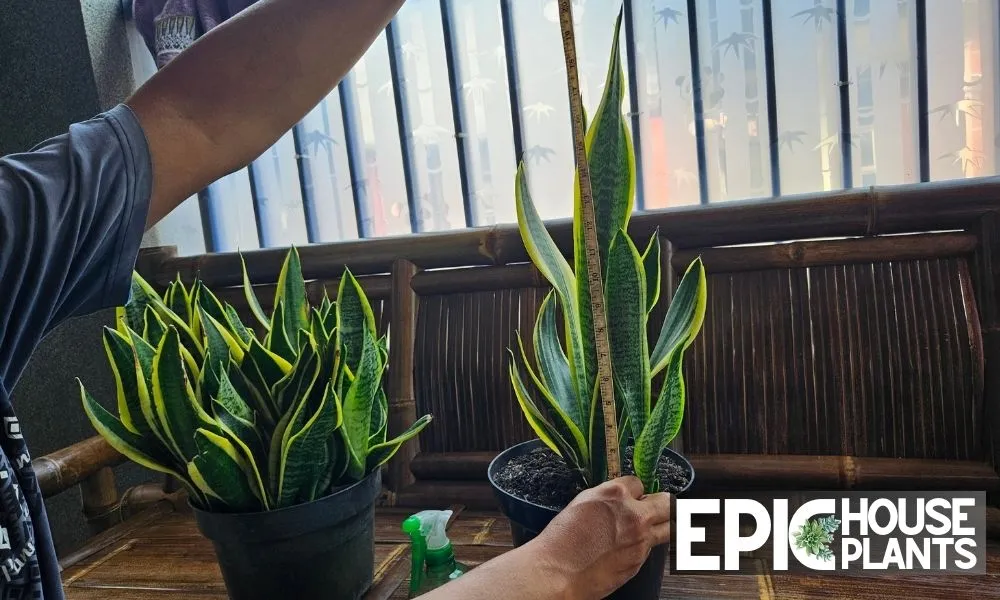Snake plants, scientifically known as Dracaena trifasciata, are popular and hardy houseplants, known for their stiff, sword-like leaves that come in various colors with green-banded or striped leaves and a yellow or cream border.
But have you ever wondered how long a snake plant can live? Well, you’re about to find out. This article will delve deep into the lifespan of snake plants, how they grow, their life cycle, and the key factors to increase their lifespan.

The Lifespan of a Snake Plant
The lifespan of a snake plant is a fascinating topic as these plants have some impressive longevity.
In optimal conditions, a snake plant can live for over 25 years. However, the average lifespan across all snake plant varieties is roughly 10 years.
This long lifespan is one reason why snake plants are a popular choice for homeowners and plant enthusiasts alike.
Factors and Conditions
The lifespan of a snake plant can vary depending on several factors. Understanding these factors and details is essential for the proper care and longevity of this popular houseplant.
Monocarpic Nature of Snake Plants
Interestingly, snake plants are monocarpic, which means each rosette of a snake plant can only produce a flower spike once in its life. After the snake plant produces its flower, it won’t ever grow any foliage.
However, this doesn’t mean the plant dies; instead, it lives on for many years until the leaves die one by one, beginning with the oldest leaf.
💡Also Read: Consider reading this comprehensive guide on Repotting Snake Plant Like a Pro: A Comprehensive Guide.
The Impact of Care and Environment

While snake plants are known for their hardiness, the longevity of these plants can vary significantly based on the care and environmental conditions they receive. Some factors that play a pivotal role in a snake plant’s lifespan include:
- Watering: Overwatering can lead to root rot, a common cause of premature death in snake plants. These plants only require watering when the soil is completely dry.
- Lighting: Snake plants are adaptable and can tolerate a range of light conditions. However, they thrive best in bright, indirect light.
- Soil: Snake plants prefer well-drained soil to prevent water logging. A good quality, well-draining potting mix is essential for their health and longevity.
- Temperature: They flourish in warm temperatures. Cold, drafty areas can stunt their growth and negatively impact their lifespan.
Author Note:
By paying attention to these factors, you can help your snake plant live longer, perhaps even surpassing the 25-year mark.
Understanding the Growth Rate of Snake Plants

Compared to other houseplants, snake plants have a slower growth rate. On average, they grow about 4 to 12 inches per year. The speed of growth can vary significantly based on the growing conditions.
However, it’s worth noting that a slower growth rate isn’t necessarily a drawback. In fact, it’s one of the reasons why snake plants are such low-maintenance, long-living houseplants.
Their slower growth rate also allows them to maintain their structural integrity and aesthetic appeal for a longer period, making them a perennial favorite among houseplant enthusiasts.
💡Also Read: For tips on how to accelerate the growth of your snake plant, head over to How Fast Do Snake Plants Grow? (6 Tips for Accelerated Growth).
The Life Cycle of a Snake Plant
The life cycle of a snake plant is a fascinating journey from a seed to a full-fledged mature plant. Although most snake plants are multiplied by cuttings, transplanting pups, and by division, the life cycle of the plant actually starts from a seed.
The Life Cycle Begins: Seeding and Germination
Contrary to what many believe, the life cycle of a snake plant actually starts from a seed. The seeds are produced by a mature snake plant from its flowers. Although the seeds have a low germination rate, a fertile seed placed in soil will sprout and send down roots.
Author Note:
This period, however, is not immediate and requires patience. It takes several weeks for the seed to sprout and appear out of the soil after planting.
Growing Up: Young Snake Plants and Pups

After the seed sprouts, it forms a young snake plant, and over time, the leaves start to grow. As the plant matures, it will start to produce offshoots, also known as “pups” that grow to become an adult snake plant within about five years.
The parent snake plant spreads these baby snake plants via its rhizomes. Rhizomes are thick stems that grow horizontally underground, and over time, they produce new shoots, the pups.
These pups can be transplanted to create brand-new plants or left to mature as part of the snake plant clump.
💡Also Read: Interested in dividing your snake plant to create new ones? Check out this practical guide on How to Divide A Snake Plant.
Maturation and Reproduction: The Snake Plant Circle of Life
The snake plant reaches maturity around 10 years into its life. Under ideal conditions, mature snake plants produce flowers that eventually develop into seeds over time. These seeds can be used to propagate new snake plants, and thus, the cycle continues.
Here’s a breakdown of the life cycle of a snake plant:
- Seeding Phase: A mature snake plant produces seeds from its flower. These seeds have a low germination rate.
- Germination: A fertile seed that is placed in soil will sprout and send down roots. It takes several weeks for the seed to appear out of the soil after planting.
- Growth: The seed forms a young snake plant, and the leaves will grow.
- Propagation: Pups will grow into an adult snake plant in about 5 years. Adult snake plants spread the baby snake plants by rhizomes, which are thick stems that grow horizontally underground. Over time, these rhizomes produce new shoots called pups.
- Maturation: These pups can be transplanted to create brand-new plants or left to mature as part of the snake plant clump. The snake plant reaches maturity in around 10 years. Under ideal conditions, mature snake plants produce flowers that develop into seeds over time. These seeds can be used to grow new snake plants.
How to Make Your Snake Plant Live Longer: Key Factors to Consider
On the link https://epichouseplants.com/snake-plant-problems/, you can find more information about Snake Plant care and potential issues that may arise. By following the recommended care guidelines, you can increase the chances of your Snake Plant living a long and healthy life.
Some of the factors that can influence the longevity of a Snake Plant include:
Light
Contrary to popular belief, snake plants don’t thrive in the dark. They can survive in dim areas, but they won’t thrive and will often display signs of wilting, drooping, yellowing, or falling over.
Under optimal growing conditions, snake plants may even flower. To keep your plant happy and healthy, provide it with lots of bright yet indirect light. Bedrooms generally aren’t the best location for snake plants due to lack of sufficient light. Avoid placing the plants in direct light, as it can harm them.
💡Also Read: For a deeper understanding of the lighting requirements for snake plants, check out this blog post on “Do Snake Plants Need Light? Understanding The Lighting Requirements“.
Temperature and Humidity
Being native to the tropics, snake plants prefer warm temperatures. Maintain the temperature between 55-90ºF and avoid sudden swings in temperature.
Snake plants will happily thrive near radiators and other heat sources. Keep the humidity in a moderate range, around 35-45%.
Soil
Snake plants thrive in soil that holds moisture yet also provides excellent drainage. Look for a mix consisting of organic material like peat moss or coco coir and drainage materials like perlite or pine bark.
If you notice your soil is staying wet for a long time after watering, you may need to repot in a soil with better drainage.
Watering
Snake plants don’t need constantly moist soil, and overwatering is one of the biggest issues these plants face. It’s best to water your plant when the top half to two-thirds of soil is dry.
Author Note:
With the right care and conditions, snake plants can be a long-lasting addition to your indoor garden. Pay attention to their needs, provide them with a suitable environment, and they will reward you with their striking presence for many years to come.
Author

Pudji Haryanto
Pudji Haryanto is a writer and urban farmer with a passion for cultivating plants. He has over 15 years of experience in agriculture and currently manages a 65,000 square foot rice-field and yard filled with various plants, including vegetables, spices, flowers, and garden plants.
